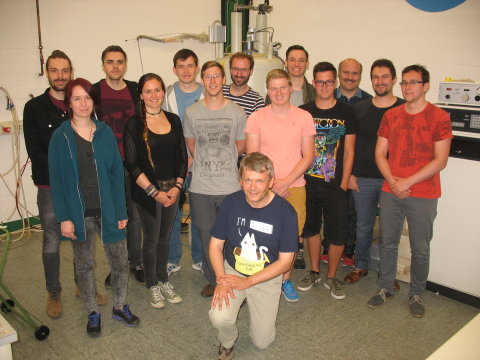Report to the 18. DMG Shortcourse "Applications of Solid State NMR Spectroscopy in the mineralogical and geoscientific research "
in Bochum from 22. May – 25. May 2018

From 22nd to 25th May, 2018 the Institute for Geology, Mineralogy and Geophysics of the Ruhr-University Bochum hosted the 18th DMG NMR short course “Applications of Solid-State NMR Spectroscopy in Mineralogical and Geoscientific Research” headed by Dr. Michael Fechtelkord. The widespread use and manifold application possibilities attracted 13 participants from different scientific fields, such as chemistry, mineralogy, solid state and materials. The complementary measurement method supports the characterization of crystalline and amorphous materials with respect to their structure and dynamic processes. The four-day workshop with a theory-session in the morning and a hands-on-session in the afternoon offered the masters and postgraduate student a comprehensive overview.
On the first day, the participants were introduced to the theoretical basics of NMR spectroscopy, the historical developments and to the experimental setup of the spectrometer. In the afternoon, the first measurements with the BRUKER ASX 400 spectrometer were conducted to determine the 1H spin lattice relaxation and dynamics of tetramethylammonium iodide with rising temperature (298-430 K). The acquired relaxation times were used to calculate the activation energy of the rotation of the methyl groups (CH3). In the evening, an Icebreaker party was organized by the course leader Michael Fechtelkord.
The second day emphasized on magnetic dipolar interactions, chemical shifts and the magic angle spinning (MAS) method, as a tool for the measuring of Free Impulse Delays (FIDs). In the afternoon, the 29Si, 19F and 1H MAS NMR spectra of synthetic phlogopite samples were recorded. Using the freeware program DMT2010 the adaptation and evaluation of the recorded spectra was conducted. The chemical shift was experimentally demonstrated through the measurement and evaluation of 13C und 1H NMR spectra.
The short course continued with Hahn’s Echo, an example for a multi-pulse technique, used to create FIDs without pulse influence. Additionally, the Incredible Natural Abundance Double Quantum Transfer Experiment (INADEQUATE) was presented. This method can be used to characterise adjacent tetrahedral sites. The theory part for the day was completed with an introduction to correlation experiments. In the afternoon a contact time dependent Cross Polarisation Magic Angle Spinning (CPMAS) experiment was carried out. From this data, it was possible to calculate the H-Si distance.
The theory of the last day covered the atomic nuclei with a spin I > ½ . The quadrupolar interaction shows the need for additional methods like Multi-Quantum Magic-Angle Spinning (MQMAS) and Satellite Transition Spectroscopy (SATRAS). During the practical part in the afternoon, we measured Glauber’s salt (23Na) with the MAS method. Furthermore, we performed a SATRAS measurement at corundum (27Al). In addition to the 23Na experiment, a static deuterium and 7Li NMR spectrum was evaluated.
Finally, on the behalf of all participants we would like to sincerely thank Dr. Fechtelkord for a more than successful short course. After a short introduction to the basics of NMR Spectroscopy, Dr. Fechtelkord offered a broad overview over the possibilities within Geoscience, chemistry and material-sciences. Comprehensive and patient explanations, as well as a constant supply of coffee and tea in the afternoon resulted in an instructive week. We also want to thank all the other participants for a successful short course and a great week.
Mara Lönartz,
Moritz Malott,
Bonn


